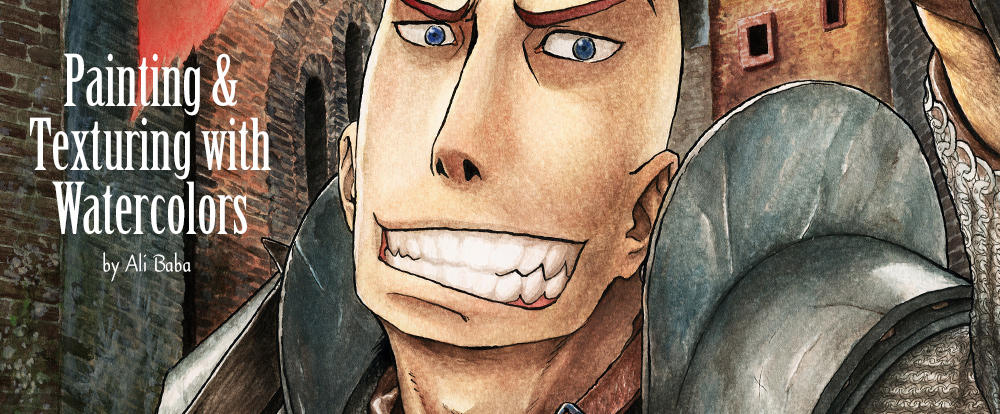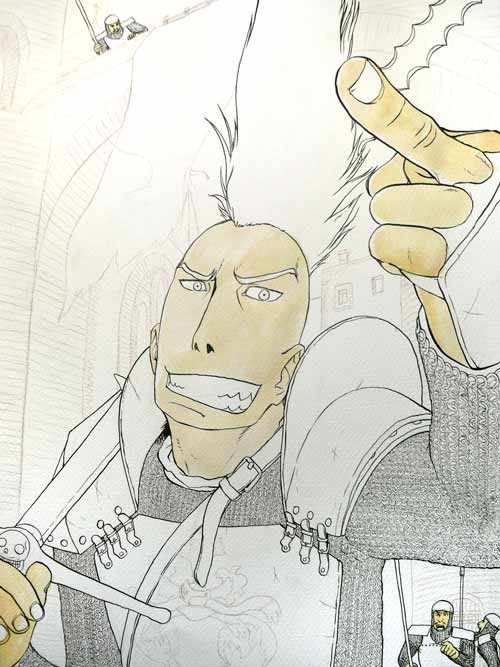Ali's Tutorials » Painting & Texturing with Watercolors

Welcome!
Today I’m going to show you the watercoloring techniques I used to create my “I Quit"” artwork.
You don't need much experience with watercolors to follow this tutorial, as I'm going to explain everything in detail.

Tools
When it comes to painting with watercolors a quality-brush is a must!
You can generally choose between natural hair brushes or synthetic ones. However, natural sable brushes can be very expensive, while the synthetic ones are fairly cheap.
How to find good brushes
While natural brushes tend to produce better results, there most certainly exist good synthetic brushes that will aid you just as well.
But be careful not to buy the kind of brushes I marked as crap in the picture above XD !
How can you tell between good and bad brushes? Here’s a quick list:
- Good brushes usually have finer and more hair strands, while cheap ones have rougher, fewer and less elastic hair
- It should be very hard to pull out hair from a good brush, while bad ones loose hair easily
- A good brush will get very sharp at the point when it’s wet. A bad brush won’t change its shape.
- Bad brushes are usually not sharpened at the end (but sometimes they are! Beware!)
If you know what you need to look out for, it’s quite easy to tell apart good brushes from bad ones =)

Brush types
For this tutorial I'm going to use only one brush of the size 8 (a synthetic one). Although it’s quite a big one, it is good enough even for fine details since its point is very sharp.
I’ll use the brush both in its wet state and in a dry-ish (very little water, more color) state in order to achieve different textures and effects.

Colors
On to the colors!
It’s not necessary to have a lot of different colors, in fact it’s much easier to work with a limited palette. For the most part, I will only use these six colors, as well as black for deep shadows and white for some special effects.
Sometimes it may be good to add additional colors to accentuate specific elements. Just remember that less is usually more, since fewer colors make the whole image more homogenous, while many different colors can literally make it difficult to look at.

Glazing
We'll be using these two techniques all the time. Glazing/ Layering is arguably the most important aspect of watercoloring and it makes it quite easy for us to get cool textures and effects.
The Wet-to-wet-technique is useful in order to achieve relatively smooth gradients. We will use it less often in this tutorial, because the wet-to-dry-technique (or dry-to-dry) is much better suited for the rough textures we’re aiming for.
One advice: keep a sheet of paper handy in order to experiment with different combinations before applying them to your artwork. It’s very hard to correct mistakes with watercolors if anything goes wrong, so better safe than sorry.

Draft
As usual, the first thing to do is sketch out your drawing with pencils.
Be light on the pressure in order not to damage the paper, as it can influence the watercolors.

Inking
The next step is to ink all the characters, but leave the background without outlines to achieve a visual separation between the characters and their surroundings.
However, in order to not lose the contours of the bg when we erase the sketch, we’ll just outline them with a colored pencil, which isn’t as easy to erase as a graphite pencil.

The chainmail pattern
The chains were no doubt the most elaborate part of the inking.
If you really want to give it a try, here’s the technique I used.
However, don’t forget to follow the shape of the body and be careful of the distortion through the perspective. It takes quite a lot of practice to get it right.

Skin tones
Now we’re finally ready to get to the coloring.
In this case, for no special reason, I started with the skin.
So, how are we going to create a believable skin texture?
The answer is: in multiple layers.
We will use a light 'flat' color for the basic skin color first.
Then we will add shadows and texture with a dark color; to make it look lifelike and three dimensional.
Lastly we’ll add “life” to the skin by adding some reds.
Since it's a good idea to start with lighter colors and then gradually transit to darker tones, for the first layer we’ll go with a light ochre.
At this point, you should be conscious of light situation of the scene. In this case, the light source should come from the upper left hand side.

Ochre
Especially if you are mixing your colors, it's best to paint in all the parts at once.
Here I added the ochre skin tones to all characters that I wanted to have them.
This way, there's no risk of getting a slightly different tone when you mix it again.

Red and brown layers
After the first layer has dryed, we can go on to the next.
We’ll use umber for the shadows and details in the skin, while we use orange / red to “liven” the skin up.
A fairly dry brush is well suited to create the wrinkles and pores of the skin with umber.
For the red accents a slightly wetter brush may be better. Also, try to think about which parts of the body have better blood supply (usually fingertips, joints, nose, ears, lips, etc.) and add more reds to these parts.

Fingernails
The fingernails can be colored with umbra or red alone. Be careful to leave some highlights and make sure to use straight strokes to accentuate the shape of the fingernails.

Skin shadows
All that's left is to add the rest of the shadows and wrinkles with umber. Try not to use real black for the skin, most of the time a deep umber is more than enough.
(Depending on the mood you want to achieve, using other colors like dark blues can be good, too)

Warm colors
Once the umber has dryed, we can add more red and orange to add more life to the skin.
Be subtle when you add additional layers. You can always add more, but if you find that you have added to much of a color, it will be tough to remove.

Hair coloring
When we’re done with the coloring of the skin, how about moving on to the hair next?
For the hair, we’ll have to use more water and long, curvy strokes.
It’s best to first define the flow of the hair with a dark umber. Remember to leave highlights at the appropriate parts.
After that, we can paint the colored strands, in this case in red. Our brush has to be charged with enough water and color, so that we can paint the strands with long strokes.

Coloring the chainmail
Well, the hair wasn’t too hard. How about something a little more challenging XD ?
Yes, we’re going to take on the chainmail next.
It would be insane to paint every chain by itself of course, so we’ll have to use a few tricks.
The technique we will use is similar to how we made the hair – defining the darker parts with umber, then coloring the rest, while leaving some shiny highlights.
You may want to use more water and less color this time and go a couple of times over the same definitions. Make sure to use the same directions, but don’t be too concerned with accuracy. It's the overall look that matters now (since the details have already been inked).
Lastly, we can add a bit of black for the shadowy parts.

Coloring the metal plates
On to something easier: the plates.
What I used for it is a bit of black and umber and a very dry brush. With pretty much random strokes it’s easy to get a believable rough looking steel-texture. Again, it won’t hurt to leave some highlights, especially for the scratches (although you can also add them with whites later).
Lastly I decided to add a light blue to a few parts of it to cool it off.

Shoulder plates
The shoulder plate can be painting with the same technique – adding a bit of blue, black and umber here and there with a dry brush and leaving a few highlights.

Painting the skull
Painting in the black skull is quite simple, since it’s sufficient to only use black. We just have to keep the light source in mind and leave highlights where they belong.

First layer of the background
By now we should be pretty much done with the character. It’s time to work on the background!
Naturally this is the part that takes the longest, but with the right technique it’s not too hard.
So how are we going to do it? Basically just like we did the skin - in two to three layers.
Therefore we will start with a light umbra to get the basic tone down with a dry brush. It’s a good idea to leave some random highlights.
Now on to the second layer. We’re going to define some bricks on the outsides of the wall and the window. For that, we’ll use a wet brush and add some thick strokes that will resemble the bricks.
Instead of blue, any other color except green and yellow should work, try using different colored bricks for different buildings. You may want to mix your color with a bit of black or umber so that it won't look too lucid and overly saturated.

More layers for the bricks
The first layer of bricks looks a bit weak at the moment, so we’ll simply add another one with a darker tone.
Lastly we’ll paint slight hints of bricks on the rest of the wall. For this we use less color and more water.

Finishing touches
Since we want the brick walls to have a natural, worn-down look, we'll add some special effects to make them look less bland.
These castle walls are supposed to be quite old, so let’s add some mold!
We’ll use a very dry brush and randomly add some greens here and there. The greens should be stronger at the bottom of the walls and get weaker at the top.
But this is still not enough!
Let’s use our opaque white to add some other old age symptoms!
With dots, circles and random strokes we can get the walls to look a lot more realistic.
Comments
You need to be logged in to write comments.



What is the type of paper you use for watercolour??